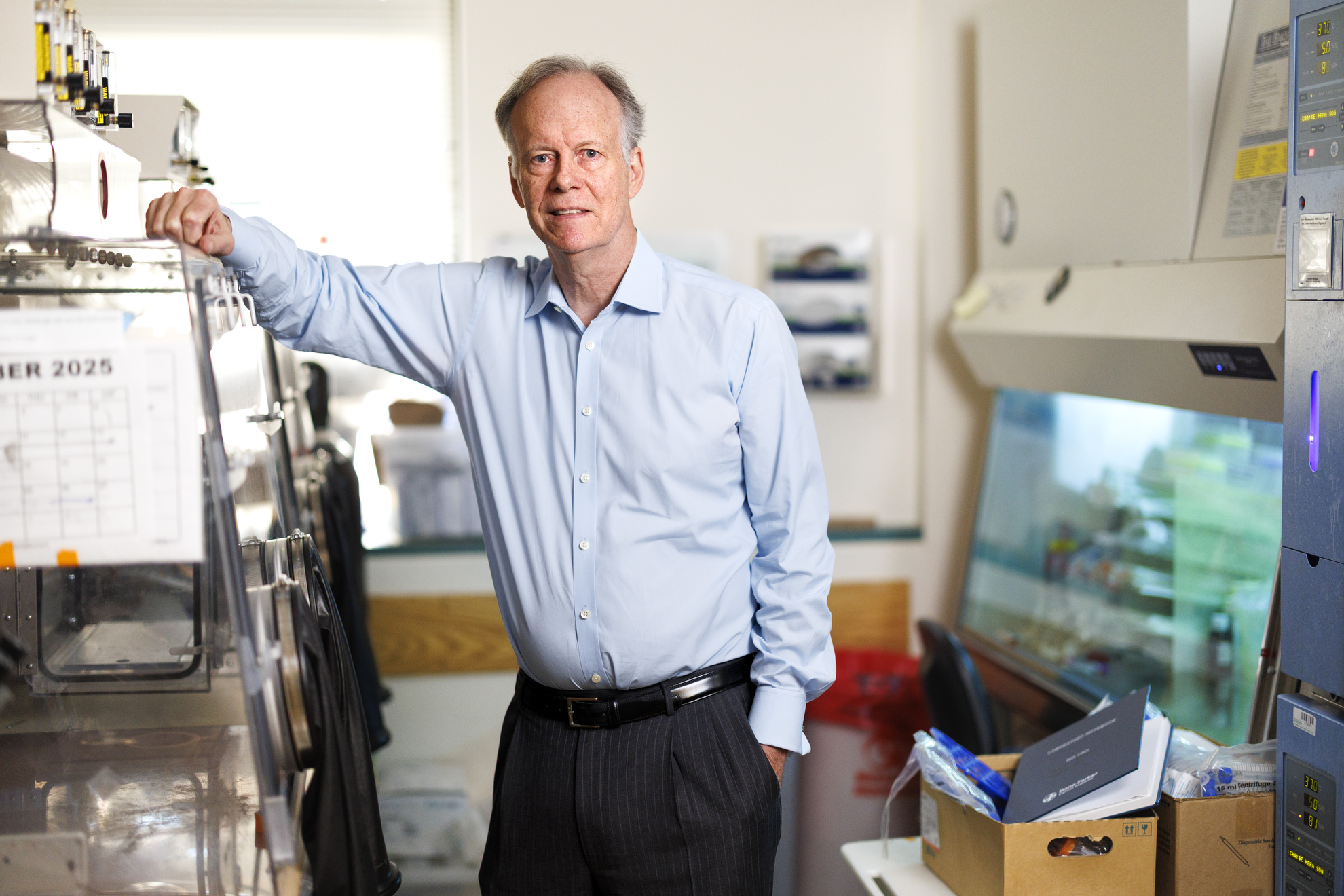Reeling in a big scientific discovery
Reeling in a big scientific discovery
William Kaelin pursued Nobel-winning findings using a fisherman’s instinct

Scientific discovery, according to William Kaelin, is a little bit like fishing: You can be taught how to bait a hook or cast a line, but there is an art to knowing where to look for the big one.
Over the course of decades, Kaelin meticulously discovered a fundamental physiological mechanism: the way that cells sense and respond to oxygen levels. The work led to novel treatments for kidney cancer, and in 2019 it earned him a joint Nobel Prize in physiology or medicine, along with Peter Ratcliffe and Gregg Semenza.
Kaelin says the groundbreaking research, which also has implications for the treatment of conditions such as anemia and heart attacks, was based on looking in the right place.
“A lot of science is just seeing connections and possibilities,” said Kaelin, the Sidney Farber Professor of Medicine at Dana-Farber Cancer Institute and Harvard Medical School. “I used to think it was mostly about mastering fancy techniques, but that is really of secondary importance. It’s really picking a good question to work on, and seeing a possible connection that other people hadn’t seen.”
Kaelin, who was born in 1957 and grew up fishing with his dad on the south shore of Long Island, recalls his parents supplying him with chemistry kits, construction toys, and a microscope to foster an interest in the sciences. “We were in the midst of the Cold War and the space race,” he said. “Scientists and engineers were celebrated.”
“A lot of science is seeing connections and being primed to recognize a possibility. But to get to that point, you have to invest in educating people.”
He was drawn to mathematics, where problems have one correct answer, and computer science, where a simple message to the mainframe leads to a clear result. At Duke University, he pursued a pre-med degree and went on to medical school. It was during his third year, while he was working in a lab studying blood flow to tumors, that he made the first observation that would send him down his Nobel-winning path. “I started reading about this unusual disease called von Hippel-Lindau disease,” he said.
Patients with von Hippel-Lindau disease, or VHL, develop tumors in multiple organs. The tumors, Kaelin learned, somehow stimulate the excess formation of new blood vessels, a process called angiogenesis.
Years later, when he was chief medical resident at Johns Hopkins, VHL showed up again in a different body of literature, listed as a cause of excess red blood cell production.
He remembers thinking at the time: “Here’s von Hippel-Lindau disease-related tumors. What are they doing on this list?”
He was learning to think like a scientist.
When Kaelin launched his own lab at Dana-Farber, he returned to the lingering puzzle. His working hypothesis: Since increased angiogenesis and increased red blood cell production are two ways that tissues try to deal with low oxygen, perhaps the VHL gene was required for cells to sense oxygen properly. He reasoned that studying the VHL gene could teach him about angiogenesis, about oxygen sensing, and even about a common cancer, namely kidney cancer. That’s because even non-hereditary kidney cancers usually have acquired VHL mutations at some point in the patient’s lifetime, in contrast to VHL disease, where a mutation is inherited.
“I was the product of bipartisan support for science and engineering, not just in terms of funding, but also messaging.”
There was particular interest around angiogenesis when Kaelin started his laboratory because of the pioneering work of Harvard professor Judah Folkman, who championed the idea of treating cancers with angiogenesis inhibitors.
“If we were going to have angiogenesis inhibitors, we were really going to need to understand the molecular circuitry that controls angiogenesis,” Kaelin said. “Seemingly, the VHL gene and its protein product must play some role in this, because if it’s defective, you make too many blood vessels.”
It was known that VHL gene mutations caused VHL disease, but the question was how. Like most genes, the VHL gene contains the instructions for a protein, in this case called the VHL protein. Kaelin’s research — much of it supported by federal funding — confirmed the hypothesis that the VHL protein is required for oxygen sensing. Together with others in the field, his work showed that the protein binds to a protein called HIF-alpha and targets it for destruction, unless oxygen is scarce. In other words, HIF-alpha is the master regulator of the cell’s response to low oxygen.
In healthy cells, VHL keeps HIF-alpha in check. But when the VHL gene is mutated, as in VHL-associated tumors, HIF-1-alpha accumulates, aberrantly triggering the overproduction of red blood cells and abnormal blood vessel growth — the hallmark of VHL disease and of many cancers.
The finding explained many of the clinical characteristics of VHL-associated tumors, but it still begged the question of how the VHL protein “knows” whether oxygen is present, and hence whether to target HIF-alpha for destruction. Kaelin and his co-Nobelist Ratcliffe, working independently, showed that a little chemical “flag” is added to the HIF-alpha protein when oxygen is present, which signals the VHL protein to degrade the HIF-alpha.
The mechanism is elegant in its simplicity, a basic balancing of elements in the body that was not understood until the right person with the right training asked the right question. Kaelin says it’s gratifying that the research led to the development of drugs that target the oxygen-sensing process, leading to new treatments for cancer and for anemia caused by kidney failure.
“A lot of science is seeing connections and being primed to recognize a possibility,” he said. “But to get to that point, you have to invest in educating people, training people, exposing them to different ways of thinking, exposing them to what’s been done before them.”
Kaelin worries that the esteem for science that sent him on his path might not support the next generation. Although his lab thus far has not been affected by the federal government’s cancellation of some $2.2 billion in research funding to Harvard, he has been devastated to see the impact on his colleagues. (A U.S. District Court in September ruled the government acted unlawfully when it cut grants, and previously frozen research dollars have started flowing to researchers again.)
“I was the product of bipartisan support for science and engineering, not just in terms of funding, but also messaging — again, treating scientists and engineers like heroes,” he said. “It set up a virtuous cycle, because we were attracting talent and investing money, so we were doing great science. This was perceived as a place to do great science, which meant we attracted more science and more capital. Now it seems like we’re doing all the things that you would do to try to undo that.”
Latest Harvard
- Time for mandatory retirement ages for lawmakers, judges, presidents?Americans seem to mostly say yes; legal, medical scholars point to complexities of setting limits
- In dogs, as in humans, a harsh past might bare its teethEarly adversity leads to higher aggression and fearfulness in adult canines, study says
- Brief bursts of wisdomAphorism lover and historian James Geary reflects on how ancient literary art form fits into age of social media
- Flew home as Will Flintoft, returned as Rhodes ScholarApplied math concentrator to study computer science, theology with eye toward AI
- What will AI mean for humanity?Scholars from range of disciplines see red flags, possibilities ahead
- Tai Tsun Wu, 90Memorial Minute — Faculty of Arts and Sciences






